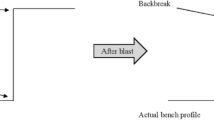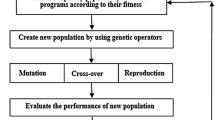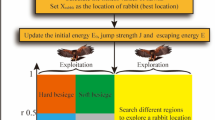Abstract
Backbreak (BB) is a detrimental outcome of blasting activities in mineral extraction processes within mines. It involves the development of fractures and cracks at considerable distances behind the last row of blast pits, leading to reduced bench safety and increased operational costs. Given the multitude of factors influencing BB, various techniques have been developed to predict and optimize its occurrence. This particular study focused on analyzing 48 blasts in the tailings section of Gol Gohar Mine No. 1 to forecast BB using the whale optimization algorithm (WOA), multiverse optimizer (MVO), sine cosine algorithm (SCA), ant lion optimizer (ALO), and multivariate linear regression (MLR). Comparative analysis of the four BB prediction models revealed that the MVO algorithm yielded the most favorable outcomes, with the train data exhibiting parameter values of 0.9901, 0.2161, 0.1127, 98.8472, and 0.0180 for R2, RMSE, MSE, VAF, and MAPE, respectively, while the test data displayed values of 0.6357, 1.4955, 1.2003, 63.5472, and 0.1951 for the same parameters. In addition, the analysis specifically emphasized the substantial influence of spacing, burden, and GSI as the primary determinants of the backbreak phenomenon. In stark contrast, however, powder factor, delay time, and joint condition are identified as having negligible effects on backbreak.














Similar content being viewed by others
Data availability
Enquiries about data availability should be directed to the authors.
References
Agrawal H, Mishra A (2019) Modified scaled distance regression analysis approach for prediction of blast-induced ground vibration in multi-hole blasting. J Rock Mech Geotech Eng 11(1):202–207
Al-Bakri AY, Sazid M (2021) Application of artificial neural network (ANN) for prediction and optimization of blast-induced impacts. Mining 1(3):315–334
Armaghani DJ, Koopialipoor M, Bahri M, Hasanipanah M, Tahir M (2020a) A SVR-GWO technique to minimize flyrock distance resulting from blasting. Bull Eng Geol Env 79(8):4369–4385
Armaghani DJ, Mirzaei F, Shariati M, Trung NT, Shariati M, Trnavac D (2020b) Hybrid ANN-based techniques in predicting cohesion of sandy-soil combined with fiber. Geomech Eng 20(3):191–205
Bhagade NV, Murthy V (2020) Controlling backbreak and enhancing fragmentation in dragline bench blasting—a geo-engineering approach. Arab J Geosci 13(7):1–20
Bhandari S (1997) Engineering rock blasting operations
Dai Y, Khandelwal M, Qiu Y, Zhou J, Monjezi M, Yang P (2022) A hybrid metaheuristic approach using random forest and particle swarm optimization to study and evaluate backbreak in open-pit blasting. Neural Comput Appl 34:1–16
Eskandar H, Heydari E, Hasanipanah M, Masir MJ, Derakhsh AM (2018) Feasibility of particle swarm optimization and multiple regression for the prediction of an environmental issue of mine blasting. Eng Comput 35:363–376
Esmaeili M, Osanloo M, Rashidinejad F, Aghajani Bazzazi A, Taji M (2014) Multiple regression, ANN and ANFIS models for prediction of backbreak in the open pit blasting. Eng Comput 30:549–558
Ghanizadeh AR, Delaram A, Fakharian P, Armaghani DJ (2022) Developing predictive models of collapse settlement and coefficient of stress release of sandy-gravel soil via evolutionary polynomial regression. Appl Sci 12(19):9986
Hasanipanah M, Bakhshandeh Amnieh H (2021) Developing a new uncertain rule-based fuzzy approach for evaluating the blast-induced backbreak. Eng Comput 37(3):1879–1893
Hasanipanah M, Monjezi M, Shahnazar A, Armaghani DJ, Farazmand A (2015) Feasibility of indirect determination of blast induced ground vibration based on support vector machine. Measurement 75:289–297
He B, Armaghani DJ, Lai SH (2023) Assessment of tunnel blasting-induced overbreak: a novel metaheuristic-based random forest approach. Tunn Undergr Space Technol 133:104979
Indraratna B, Armaghani DJ, Correia AG, Hunt H, Ngo T (2023) Prediction of resilient modulus of ballast under cyclic loading using machine learning techniques. Transport Geotech 38:100895
Jayasinghe B, Zhao Z, Chee AGT, Zhou H, Gui Y (2019) Attenuation of rock blasting induced ground vibration in rock-soil interface. J Rock Mech Geotech Eng 11(4):770–778
Khoshalan HA, Shakeri J, Najmoddini I, Asadizadeh M (2021) Forecasting copper price by application of robust artificial intelligence techniques. Resour Policy 73:102239
Konya CJ, Walter EJ (1990) Surface blast design. Prentice Hall
Kumar S, Mishra A, Choudhary B (2021) Prediction of back break in blasting using random decision trees. Eng Comput 38:1–7
Li D, Liu Z, Xiao P, Zhou J, Armaghani DJ (2022a) Intelligent rockburst prediction model with sample category balance using feedforward neural network and Bayesian optimization. Undergr Space 7(5):833–846
Li C, Zhou J, Tao M, Du K, Wang S, Armaghani DJ, Mohamad ET (2022b) Developing hybrid ELM-ALO, ELM-LSO and ELM-SOA models for predicting advance rate of TBM. Transport Geotech 36:100819
Mirjalili S (2015) The ant lion optimizer. Adv Eng Softw 83:80–98
Mirjalili S (2016) SCA: a sine cosine algorithm for solving optimization problems. Knowl-Based Syst 96:120–133
Mirjalili S, Lewis A (2016) The whale optimization algorithm. Adv Eng Softw 95:51–67
Mirjalili S, Mirjalili SM, Hatamlou A (2016) Multi-verse optimizer: a nature-inspired algorithm for global optimization. Neural Comput Appl 27(2):495–513
Momeni E, Armaghani DJ, Hajihassani M, Amin MFM (2015) Prediction of uniaxial compressive strength of rock samples using hybrid particle swarm optimization-based artificial neural networks. Measurement 60:50–63
Monjezi M, Dehghani H, Shakeri J, Mehrdanesh A (2021) Optimization of prediction of flyrock using linear multivariate regression (LMR) and gene expression programming (GEP)—Topal Novin mine Iran. Arab J Geosci 14:1–12
Moomivand H, Amini Khoshalan H, Shakeri J, Vandyousefi H (2022) Development of new comprehensive relations to assess rock fragmentation by blasting for different open pit mines using GEP algorithm and MLR procedure. Int J Min Geo-Eng 56(4):401–411
Onyelowe KC, Mahesh CB, Srikanth B, Nwa-David C, Obimba-Wogu J, Shakeri J (2021) Support vector machine (SVM) prediction of coefficients of curvature and uniformity of hybrid cement modified unsaturated soil with NQF inclusion. Clean Eng Technol 5:100290
Onyelowe KC, Shakeri J, Amini-Khoshalan H, Usungedo TF, Alimoradi-Jazi M (2022) Computational modeling of desiccation properties (CW, LS, and VS) of waste-based activated ash-treated black cotton soil for sustainable subgrade using artificial neural network, gray-wolf, and moth-flame optimization techniques. Adv Mater Sci Eng 2022:1–17
Parsajoo M, Armaghani DJ, Mohammed AS, Khari M, Jahandari S (2021) Tensile strength prediction of rock material using non-destructive tests: a comparative intelligent study. Transport Geotech 31:100652
Saghatforoush A, Monjezi M, Shirani Faradonbeh R, Jahed Armaghani D (2016) Combination of neural network and ant colony optimization algorithms for prediction and optimization of flyrock and back-break induced by blasting. Eng Comput 32(2):255–266
Saharan MR, Sazid M, Singh TN (2017) Explosive energy utilization enhancement with air-decking and stemming plug, ‘SPARSH.’ Procedia Eng 191:1211–1217
Sayadi A, Monjezi M, Talebi N, Khandelwal M (2013) A comparative study on the application of various artificial neural networks to simultaneous prediction of rock fragmentation and backbreak. J Rock Mech Geotech Eng 5(4):318–324
Sazid M, Singh TN (2013) Two-dimensional dynamic finite element simulation of rock blasting. Arab J Geosci 6:3703–3708
Sazid M, Singh TN (2015) Numerical assessment of spacing–burden ratio to effective utilization of explosive energy. Int J Min Sci Technol 25(2):291–297
Shakeri J, Shokri BJ, Dehghani H (2020) Prediction of blast-induced ground vibration using gene expression programming (GEP), artificial neural networks (ANNS), and linear multivariate regression (LMR). Arch Min Sci 65(2):317–335
Shakeri J, Amini Khoshalan H, Dehghani H, Bascompta M, Onyelowe K (2022a) Developing new models for flyrock distance assessment in open-pit mines. J Min Environ 13(2):375–389
Shakeri J, Asadizadeh M, Babanouri N (2022b) The prediction of dynamic energy behavior of a Brazilian disk containing nonpersistent joints subjected to drop hammer test utilizing heuristic approaches. Neural Comput Appl 34(12):9777–9792
Shakeri J, Bascompta M, Alimoradijazi M, Dehghani H (2023) Application of artificial intelligence techniques for predicting the flyrock, Sungun mine Iran. Arab J Geosci 16(8):488
Shan F, He X, Armaghani DJ, Zhang P, Sheng D (2022) Success and challenges in predicting TBM penetration rate using recurrent neural networks. Tunn Undergr Space Technol 130:104728
Sharma M, Agrawal H, Choudhary B (2021) Multivariate regression and genetic programming for prediction of backbreak in open-pit blasting. Neural Comput Appl 34:1–12
Sohrabi P, Jodeiri Shokri B, Dehghani H (2021) Predicting coal price using time series methods and combination of radial basis function (RBF) neural network with time series. Mineral Econ 36:1–10
Sohrabi P, Dehghani H, Rafie R (2022) Forecasting of WTI crude oil using combined ANN-Whale optimization algorithm. Energy Sourc Part B 17(1):2083728
Yu Q, Monjezi M, Mohammed AS, Dehghani H, Armaghani DJ, Ulrikh DV (2021) Optimized support vector machines combined with evolutionary random forest for prediction of back-break caused by blasting operation. Sustainability 13(22):12797
Zhou J, Dai Y, Khandelwal M, Monjezi M, Yu Z, Qiu Y (2021) Performance of hybrid SCA-RF and HHO-RF models for predicting backbreak in open-pit mine blasting operations. Nat Resour Res 30(6):4753–4771
Funding
No funding was received for conducting this study.
Author information
Authors and Affiliations
Corresponding author
Ethics declarations
Conflict of interest
The authors declare that they have no conflict of interest.
Ethical approval
This article does not contain any studies with human participants or animals performed by any of the authors.
Additional information
Publisher's Note
Springer Nature remains neutral with regard to jurisdictional claims in published maps and institutional affiliations.
Rights and permissions
Springer Nature or its licensor (e.g. a society or other partner) holds exclusive rights to this article under a publishing agreement with the author(s) or other rightsholder(s); author self-archiving of the accepted manuscript version of this article is solely governed by the terms of such publishing agreement and applicable law.
About this article
Cite this article
Sorabi, P., Ataei, M., Jazi, M.R.A. et al. Utilizing heuristic strategies for predicting the backbreak occurrences in open-pit mines, Gol Gohar Mine, Iran. Soft Comput (2024). https://doi.org/10.1007/s00500-023-09613-8
Accepted:
Published:
DOI: https://doi.org/10.1007/s00500-023-09613-8




